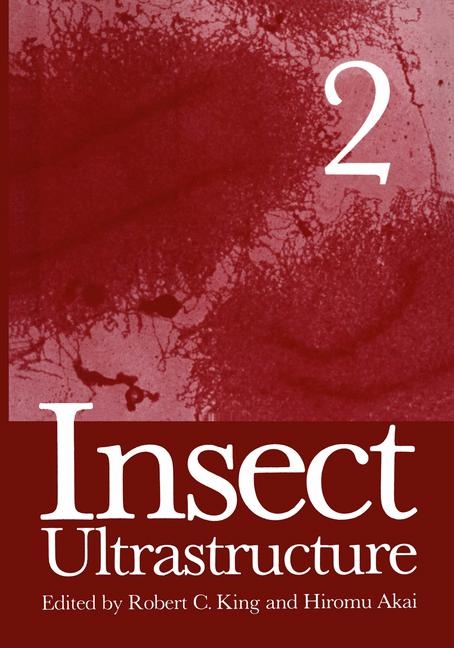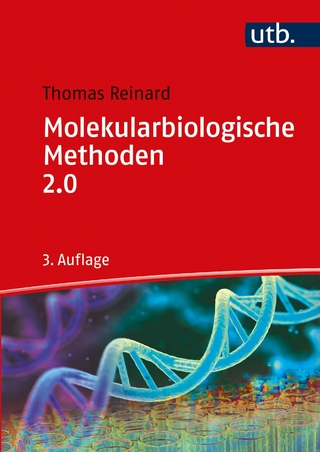
Insect Ultrastructure
Kluwer Academic/Plenum Publishers (Verlag)
978-0-306-41545-6 (ISBN)
- Titel ist leider vergriffen;
keine Neuauflage - Artikel merken
I. The Ultrastructure of Developing Cells.- 1 The Ultrastructure and Development of the Telotrophic Ovary.- 1. Introduction.- 1.1. Groups Having Telotrophic Ovaries.- 2. Adult Ovary—General Aspects.- 3. Ovarian and Ovariole Sheaths, Tunica Propria, and Terminal Filaments.- 4. Inner Sheath or Interstitial Cells.- 5. Tropharium—General Features and Nurse Cell Functions.- 5.1. Nurse Cell Nuclear Morphology.- 5.2. Nurse Cell Cytoplasm.- 6. Tropharium—Arrangement of Nurse Cell Compartments.- 7. Trophic Cords or Trophic Tubes.- 8. Nurse Cell-Oocyte Interaction: Transport Regulation and Mechanisms.- 9. Oocytes: General Features, Nuclear Morphology, Cortex Morphology.- 10. Follicle Cells.- 11. Adult Ovary Summary.- 12. Ovarian Development: General Aspects.- 13. Postembryonic Early or Larval Ovary Stages: Mitotic Growth and Establishment of Somatic Tissue-Germ Cell Interaction.- 14. Postembryonic Late Ovary Stages: Larval-Adult Transformation, Nurse Cell, and Oocyte Differentiation.- 15. Summary.- References.- 2 Early Embryogenesis of Bombyx mori.- 1. Introduction.- 2. The Structure of Mature Eggs from the Oviduct.- 2.1. The Micropylar Region.- 2.2 Other Egg Regions.- 3. Maturation and Fertilization.- 3.1. Structure of Sperm in the Spermatheca.- 3.2. Changes of the Vitelline Membrane and Periplasm Accompanying the Entry of Sperm.- 3.3. The Sperm and Egg Nuclei.- 4. Cleavage and Blastoderm Formation.- 4.1. The Cleavage Stage.- 4.2. The Formation of Blastoderm Cells.- 4.3. The Vitellophages.- 5. Formation of the Germband and the Embryonic Envelopes.- 5.1. TheGermband.- 5.2. The Serosa and the Amnion.- 6. Summary.- References.- 3 Electron Microscopic Mapping and Ultrastructure of Drosophila Polytene Chromosomes.- 1. Introduction.- 2. Light Microscopic Maps of the Salivary Gland Chromosomes of Drosophila melanogaster.- 3. Electron Microscopic Methods for the Mapping of Polytene Chromosomes.- 3.1. Thin-Sectioning of Squashed Chromosomes.- 3.2. Electron Microscopy of Whole-Mounted Polytene Chromosomes.- 4. Electron Microscopic Maps of the Salivary Gland Chromosomes of Drosophila melanogaster.- 5. Ultrastructural Studies on Drosophila Polytene Chromosomes.- 5.1. Ultrastructure of Interbands.- 5.2. Ultrastructure of Bands.- 5.3. Functional Organization of Polytene Chromosomes.- 6. Local Variation of the Degree of Polyteny.- 7. Summary.- References.- II. The Ultrastructure of the Development, Differentiation, and Functioning of Specialized Tissues and Organs.- 4 The Structure of Insect Muscles.- 1. Introduction.- 2. Contractile System.- 2.1. Myofilament Organization and Disposition.- 2.2. Z-Band Structure and Supercontraction.- 2.3. Paramyosin and Connecting Protein.- 3. Muscle Insertions.- 4. Membrane Systems.- 4.1. General Features.- 4.2. Synchronous Muscles.- 4.3. Asynchronous Muscles.- 5. Tracheation.- 6. Summary.- References.- 5 The Structure and Development of the Vacuolar System in the Fat Body of Insects.- 1. Introduction.- 1.1. The Fat Body.- 1.2. The Ultrastructure of Fat Body Cells.- 1.3. The Fat Body Vacuolar System.- 1.4. Kinds of Fat Body Vacuole.- 2. Posttransition Compartments.- 2.1. Tyrosine Storage Vacuoles and Provacuoles.- 2.2. Urate Storage Vacuoles.- 2.3. Urate Granules.- 2.4. Protein Storage Granules.- 2.5. Secretory Vesicles.- 2.6. Vacuoles Containing Symbionts.- 2.7. Vacuoles Associated with Glycogen.- 2.8. Autophagic Vacuoles.- 2.9. Multivesicular Bodies.- 2.10. Lamellar Bodies.- 2.11. Basal Lamina Phagocytic Vacuoles.- 3. Pretransition Compartments.- 3.1. Distensions of the RER.- 3.2. Peroxisomes.- 3.3. Concretions in the RER.- 4. Discussion.- 5. Summary and Conclusions.- References.- 6 The Ultrastructure of the Digestive and Excretory Organs.- 1. Introduction.- 2. The Midgut: General Organization.- 2.1. Structure of the Wall.- 2.2. Striated Border.- 2.3. Basement Membrane (Basal Lamina) and Related Structures.- 3. Types of Epithelial Cells in the Midgut.- 3.1. Columnar Cells.- 3.2. Goblet Cells.- 3.3. Peculiar Secretory Cell Types: The Goblet Cells of Thysanura and the Bottle-Shaped Cells of Odonata.- 3.4. Endocrine Cells.- 3.5. Storage Products of the Columnar Cells.- 3.6. Secretion of the Peritrophic Membrane.- 4. Changes in Fine Structure.- 4.1. Functional Subdivisions of the Gut and Cellular Cycles.- 4.2. Effects of Unsuitable Diets and Starvation.- 4.3. Blood-Sucking Insects.- 5. Cell Degeneration and Renewal.- 5.1. Cell Degeneration.- 5.2. Cell Differentiation.- 5.3. Differentiation of Microvilli in Embryonic Cells.- 5.4. Peculiar Aspects of Metamorphosis in Some Holometabola.- 6. The Proctodeal Fermentation Chambers.- 7. Filter Chambers and Related Organs.- 7.1. Midgut Filter Chambers.- 7.2. The Composite Segment of Termite Intestines.- 8. The Salivary Glands.- 8.1. The Tubular Glands of Adult Flies.- 8.2. The Tubular Salivary Glands of Adult Lepidoptera.- 8.3. The Tubular Salivary Glands of Mosquitos.- 8.4. The Acinar Glands of Dictyoptera and Orthoptera.- 8.5. The Sac-Shaped and Tubular Salivary Glands of Lower Diptera.- 9. The Malpighian Tubules.- 9.1. The General Organization of the Malpighian Tubules.- 9.2. Types of Cells.- 9.3. Compounds Deposited in the Lumen of the Tubules.- 10. The Proctodeum.- 10.1. General Organization of the Epithelium.- 10.2. Types of Epithelial Cells.- 11. The Pericardial Cells.- 12. The Other Excretory Organs.- 13. Concluding Remarks.- References.- 7 The Ultrastructure of Interacting Endocrine and Target Cells.- 1. Introduction.- 2. The Insect Endocrine System.- 3. The Ultrastructure of the Endocrine Glands of Manduca.- 4. The Corpora Allata.- 4.1. Synthesis of Juvenile Hormone.- 4.2. Secretion of Juvenile Hormone.- 4.3. Axons of PTTH Release.- 4.4. Degradation of Juvenile Hormone.- 5. Prothoracic Glands.- 5.1. Synthesis of Ecdysone.- 5.2. Secretion of Ecdysone.- 5.3. Stimulation of Prothoracic Glands by PTTH.- 5.4. Stimulation of Prothoracic Glands by 20HE.- 6. Summary of Gland Cell Structure.- 7. Target Tissue: Epidermal Cells and Cuticle Secretion.- 7.1. Hormonal Influences on the Epidermis.- 7.2. Effects of Ecdysteroids on the Epidermis.- 7.3. Effects of Juvenile Hormone on the Epidermis.- 8. Summary of Target Tissue Responses to Hormones.- 9. Conclusions.- References.- 8 The Fine Structure of Insect Glands Secreting Waxy Substances.- 1. The Waxy Secretions of Insects.- 1.1. Chemical Properties.- 1.2. Site of Synthesis of Waxy Secretions.- 1.3. The Function of Insect Waxes.- 1.4. The Economical Importance of Insect Waxes.- 2. Classification of Wax Glands.- 2.1. Classification of Epidermal Glands.- 2.2. Simple Wax Glands.- 2.3. Complex Wax Glands.- 2.4. The Mechanism of Pattern Formation by the Products of Wax Glands.- 3. Development of Wax Glands.- 4. Taxonomic Importance of Wax Glands.- References.- 9 The Ultrastructure and Functions of the Silk Gland Cells of Bombyx mori.- 1. Introduction.- 2. The General Cytology of the Silk Gland.- 3. The Ultrastructure and Functioning of the Silk Gland Cells.- 3.1. Posterior Silk Gland.- 3.2. Middle Silk Gland.- 3.3. Anterior Silk Gland.- 3.4. Filippi’s Gland.- 3.5. Liquid Silk and the Cocoon Filament.- 4. The Hormonal Control of Silk Gland Development.- 5. Mutations Influencing Silk Production.- 6. Summary.- References.- 10 Structure and Development of Male Accessory Glands in Insects.- 1. Introduction.- 2. Accessory Glands and Their Secretions.- 3. Muscular Coats and Basement Membranes.- 4. The Secretory Epithelia.- 4.1. Intercellular Junctions.- 4.2. Absorption of Precursors.- 4.3. Biosynthetic Machinery.- 4.4. Export of Product.- 5. Semisolid Secretory Products.- 5.1. Organized Secretion Masses.- 5.2. Secretion into Separate Compartments Arranged in Series.- 5.3. Secretion in Parallel to a Common Lumen.- 6. Formation of the Spermatophore.- 7. Evacuation of the Spermatophore.- 8. Development of Accessory Glands.- 9. Endocrine Control of Accessory Gland Development.- 10. Summary and Prospects.- References.- 11 The Photoreceptor Cells.- 1. Introduction.- 2. Historical Record.- 3. Ommatidial Morphology.- 4. Photoreceptor Fine Structure.- 5. Ultrastructure of the Cell Soma.- 5.1. Rhabdom.- 5.2. Nucleus.- 5.3. Endoplasmic Reticulum.- 5.4. Screening Pigment Granules.- 5.5. Mitochondria.- 5.6. Golgi Material.- 5.7. Ciliary Structures.- 5.8. Other Intracellular Structures.- 6. Cells Associated with Photoreceptor Cells.- 7. The Axon.- 8. The Synapse.- 8.1. Chemical Synapses.- 8.2. Electrical Synapses.- 9. Concluding Remarks.- References.- 12 The Glial Cells of Insects.- 1. Introduction.- 1.1. Historical Concepts of Neuroglia.- 1.2. Insect Neuroglia: General Concepts.- 1.3. The Insect Eye.- 2. Ultrastructure of Insect Neuroglia.- 2.1. The Nucleus.- 2.2. Cytoplasmic Organelles.- 2.3. Elaborations of the Plasma Membrane.- 2.4. Interglial Junctions.- 3. Specialized Supporting Cells of the Insect Eye.- 3.1. Pigmented Glia.- 3.2. Tracheal Cells.- 4. Neuro-glial Junctions.- 4.1. Desmosomes.- 4.2. Septate Junctions.- 4.3. Scalariform Junctions.- 4.4. Tight Junctions.- 4.5. Gap Junctions.- 5. Structure-Function Relationships.- 5.1. Structural Support.- 5.2. The Blood-Brain Barrier and Ionic Homeostasis.- 5.3. Metabolic Commerce.- 5.4. Phagocytosis.- 5.5. Glia in Neurogenesis.- 5.6. Compartmentalization of Neuropil.- 6. Concluding Remarks.- References.- 13 Mechanosensitive and Olfactory Sensilla of Insects.- 1. Introduction.- 2. General Organization and Morphogenesis of Sensilla.- 3. Fine Structure of the Cellular Components of Sensilla.- 3.1. The Sensory Neurons.- 3.2. The Auxiliary Cells.- 3.3. Membrane Contact Structures.- 3.4. The Receptorlymph Spaces.- 3.5. Glia Cells and Neuron-Glia Interrelations.- 4. Fine Structure of Mechanosensitive Sensilla.- 4.1. General Remarks.- 4.2. Cuticular Parts.- 4.3. Cellular Parts.- 4.4. Stimulus Uptake and Transmission.- 4.5. The Macrochaetae of Calliphora.- 4.6. Filiform and Clavate Hairs on the Cerci of Acheta.- 5. Fine Structure of Olfactory Sensilla.- 5.1. General Remarks.- 5.2. Single-Walled Olfactory Sensilla with Pore Tubules.- 5.3. Double-Walled Olfactory Sensilla with Spoke Channels.- 6. Final Remarks.- References.- 14 The Cytopathology of Baculovirus Infections in Insects.- 1. Introduction.- 2. Mode of Virus Infection.- 3. Gross Pathology of Nuclear Polyhedroses of Lepidoptera.- 4. Gross Pathology of Nuclear Polyhedroses of Hymenoptera.- 5. Gross Pathology of Nuclear Polyhedroses of Diptera.- 6. Gross Pathology of Granuloses.- 7. Gross Pathology of Baculovirus of Oryctes.- 8. Gross Pathology of Parasitoid Baculovirus.- 9. Cytopathology of Occluded NPV in Lepidoptera.- 10. Cytopathology of Occluded NPV in Hymenoptera.- 11. Cytopathology of Occluded NPV in Diptera.- 12. Cytopathology of Granuloses.- 13. Cytopathology of Nonoccluded NPV in Oryctes rhinoceros.- 14. Cytopathology of Nonoccluded NPV in Gyrinus natator.- 15. Cytopathology of Nonoccluded NPV of Parasitoids.- 16. Summary.- References.- III. The Ultrastructure of Cells in Pathological States.- 15 Comparative Ultrastructure of Wild-Type and Tumorous Cells of Drosophila.- 1. Introduction.- 2. Comparative Ultrastructure of Wild-Type and Tumorous Imaginal Discs.- 3. Comparative Ultrastructure of Wild-Type and Malignant Optic Neuroblasts and Ganglion Mother Cells.- 3.1. Ultrastructure of the Neuroblasts and Ganglion Mother Cells in the Mature Wild-Type Larval Brain.- 3.2. Ultrastructure of the Neuroblasts and Ganglion Mother Cells in the Mature l(2)gl4 Larval Brain.- 4. Comparative Ultrastructure of Wild-Type and Tumorous Blood Cells.- 4.1. Ultrastructure of Blood Cell Precursors in the Hematopoietic Organs and of the Free Blood Cells in the Hemolymph of Wild-Type Larvae.- 4.2. Ultrastructure of Tumorous Blood Cells.- 5. Discussion.- References.- 16 The Cellular Defense System of Drosophila melanogaster.- 1. Introduction.- 2. Distribution of Hemocytes in the Larva.- 3. Classification of the Larval Hemocytes.- 3.1. The Plasmatocyte and Its Variants.- 3.2. The Crystal Cell.- 4. Crystal Cells in Other Drosophila Species.- 5. Phagocytosis.- 5.1. Cell Disruption as a Source of Humoral Factors.- 5.2. Absence of Opsonization in Phagocytosis.- 5.3. A Mutation Affecting Phagocytosis.- 6. Encapsulation.- 6.1. Capsule Formation in Melanotic Tumor Mutants.- 6.2. Basement Membrane as a Factor for Recognition of Self.- 6.3. Ultrastructural Examination of Basement Membrane.- 7. Differentiation of Competent Lamellocytes.- 8. Contribution of Crystal Cells to Melanization Reactions.- 9. Wound Healing.- 10. Genetic Dissection of the Cellular Defense System.- 11. Summary and Concluding Remarks.- References.- Author Index.
| Erscheint lt. Verlag | 31.8.1984 |
|---|---|
| Zusatzinfo | 228 Illustrations, black and white; 650 p. 228 illus. |
| Verlagsort | New York |
| Sprache | englisch |
| Gewicht | 1551 g |
| Themenwelt | Naturwissenschaften ► Biologie ► Genetik / Molekularbiologie |
| ISBN-10 | 0-306-41545-3 / 0306415453 |
| ISBN-13 | 978-0-306-41545-6 / 9780306415456 |
| Zustand | Neuware |
| Haben Sie eine Frage zum Produkt? |
aus dem Bereich


